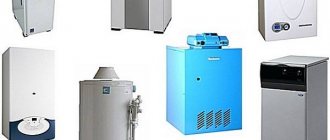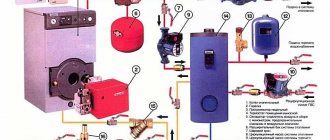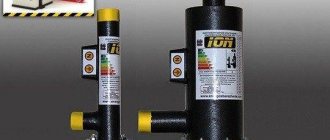ROOM MECHANICAL TEMPERATURE REGULATOR
A room mechanical thermostat is a device that regulates the operation of climate control equipment, maintaining the set temperature parameters of the room. Can be used for both heating and cooling an apartment or house.
The main difference between mechanical room thermostats and other types of thermostats is that they are a separate, completely independent device, most often made in the form of an external electrical installation product, intended for installation inside residential premises.
To put it simply, a mechanical thermostat, depending on the set program, turning on or off certain heating or cooling devices, maintains the required temperature in the room.
The main feature of a mechanical thermostat is the complete absence of electrical components, i.e. It does not require power, not even batteries, to operate.
How does a mechanical thermostat work, what exactly allows it to measure the temperature of the surrounding space and control electrical appliances?
PRINCIPLE OF OPERATION OF A MECHANICAL THERMOREGULATOR
A mechanical thermostat is a device that perfectly reflects the principle - “Everything ingenious is simple!” Despite all the differences in designs and components used, the operation of mechanical thermostats is based on one single principle, namely the ability of some materials and substances to change their mechanical properties depending on temperature.
As an everyday example, familiar to everyone, which would explain the principle of operation of a mechanical thermostat, we can cite an ordinary mercury thermometer, with which we measure body temperature.
The mercury contained inside the thermometer increases in volume as the temperature rises and enters the graduated capillary, thereby showing the exact temperature.
Approximately the same processes occur in a mechanical thermostat, the only difference is that a change in temperature to a certain level, which is indicated by us separately with a control wheel, triggers certain processes, most often closing or breaking the electrical circuit, thereby turning the heating devices on or off.
To make it clearer how it all works, let's look at the design of a standard room mechanical thermostat.
Heating thermostat
You can regulate the temperature in the room by rotating the handle of the ball valve. But it can only be in two positions: open or closed. If the valve is not completely closed, the structure will lose its tightness due to solid particles contained in the heat carrier, which damage the hinge. Therefore, for heating systems, a special thermostat with mechanical control is often used.
The heating thermostat device includes elements (see figure):
- Thermal element;
- Thermal shut-off valve;
- Adjustment scale.
- Temperature sensitive element;
- Detachable connection;
- Transmitting rod;
- Valve from spool;
- Compensatory device;
- Union nut;
- Ring for fixation;
A complex design is also characteristic of the thermal element, which is called a bellows. This is a cylinder with walls corrugated from the inside. The cavity is filled with gas or liquid - a working medium that can respond to changes in temperature around. It is this element that determines the operating principle of the heating thermostat.
Operating principle
The operating principle of a heating thermostat is based on the property of substances to increase in volume when heated and decrease when cooled. The temperature sensor responds to changes in temperature outside the structure. And each of its values corresponds to a certain pressure of the working medium, which fills the bellows cavity.
There are two possible options:
- The temperature has exceeded the value set by the consumer. Then the bellows stretches due to an increase in the volume of the working medium. This causes the rod to move, on which the operation of the shut-off valve depends. The coolant flow decreases and the temperature drops;
- The temperature has become lower than that set by the consumer. Then the bellows contracts as the volume of the working medium in it decreases. The rod begins to move in the opposite direction, opening the valve slightly. The coolant flow increases, causing the temperature to begin to rise.
These two processes constantly replace each other. Modern thermostats allow you to respond to temperature changes within one degree and even tenths of it. For a person, such a temperature difference is insignificant, and he will not notice the periodic increase and decrease.
Mechanical thermostat device
The main structural element of almost any room mechanical thermostat is a gas membrane. By the way, this is why they are often called membrane thermostats.
The special gas located inside the membrane, when the temperature changes, changes its volume, thereby affecting the walls of the membrane. Which, changing, trigger the mechanism of closing or opening the electrical circuit that supplies the heating or cooling system.
The choice of this particular method of device for a room thermostat is due to the possibility of organizing a simple way to adjust its operation temperature, as well as the fact that the device responds precisely to changes in air temperature, and not the surface, which is most important in heating and cooling systems. Therefore, for example, for heated floors it is more reasonable to use mechanical liquid thermostats with a remote sensor.
Adjustment of the response temperature of a membrane room thermostat is carried out using a control wheel with a scale, which is connected to the membrane mechanism. By turning the wheel, we move the membrane walls closer or further away from the control mechanism, thereby changing the temperature at which the electrical circuit will close or open. In other words, if the triggering mechanism is closer to the wall of the membrane, then the gas located in it only needs to change slightly in volume for it to trigger; accordingly, a lower temperature will be needed and vice versa. The adjustment wheel works on this principle.
Let's look at exactly how a mechanical thermostat can be used in the heating system of a house or apartment.
Classification and principle of operation of water temperature regulators
The water in the FGP system, according to current regulations, must have a temperature in the range from 60 to 75°C. Special devices - regulators - are responsible for this. The task is complicated by the fact that in most cases sanitary water is not heated separately, but using the power of the heating system. Moreover, in classic open circuits it is obtained simply by mixing water from the heating supply pipeline and the return line.
But there is also a more modern option that uses an indirect heating scheme. It can be used both in centralized heating units and in private autonomous heating and hot water supply systems. Its advantage is cleaner and safer hot water for humans. However, its temperature also needs to be properly regulated.
Design and principle of operation of the regulator
When using indirect heating technology, hot water is obtained by heating from the network through a heat exchanger. Thus, the temperature in the hot water supply can be adjusted by increasing or decreasing the flow of network water.
This can be achieved in different ways:
- varying the effective cross-section of pipes (by partially blocking shut-off valves);
- redirecting parts of the coolant into the return pipe;
- combining these methods.
To perform such a task, the regulator must be equipped with at least two components - a temperature sensor and an actuator that allows you to regulate the flow of network water. In addition, modern regulators are usually equipped with a control unit that allows you to program their operating parameters, as well as auxiliary devices, for example, for monitoring pressure, flow, communication, etc.
The operating principle of the water temperature regulator in GSW systems is as follows:
- the sensor detects temperature values outside the established limits;
- a control signal is supplied to the actuator;
- the actuator adjusts the intensity of the network water flow;
- the hot water temperature returns to normal values.
In a simple case, the control signal is given directly by the sensor, and in more advanced regulators this function is assigned to the control unit. To avoid water hammer, the change in the intensity of the network water flow is carried out as smoothly as possible.
Classification of temperature controllers
Design.
The simplest pneumomechanical and hydromechanical direct-acting regulators based on volume-changing bellows are still widely used due to their simplicity, low cost and energy independence.
Indirect-acting pneumatic-hydromechanical regulators with command pipelines are an improved version that works effectively on powerful gas pumps.
The most modern are electromechanical and electronic models, providing the most precise control and programming capabilities.
Sensor installation location.
The most common option is to insert a sensor at the outlet of the heat exchanger. It has a drawback - you need to take into account the cooling of water during transportation to the consumer. This can be solved by installing a sensor on the return of the hot water supply, which guarantees the required temperature for all water intake points. It is also possible to install a sensor on the supply or return water supply. Such options can be used if the coolant and water in the boiler move countercurrently or in the same direction.
Installation location of the actuator.
The most popular scheme is the insertion of a two-way valve that shuts off the supply or return section of network water. An alternative is to install a tap on the bypass.
The second option is to insert a three-way valve, which simultaneously allows part of the flow through the bypass and reduces the flow to the heat exchanger. This is the most effective and economical option.
An alternative is two two-way valves, simulating the operation of one three-way valve (rarely used).
Using a mechanical thermostat in heating
Most often, room mechanical thermostats are used in home heating, in conjunction with gas boilers. Manufacturers quite often design boilers to provide a connection diagram via a mechanical thermostat. The device is installed in the gap in the supply wire going to the boiler and when the air temperature in the room drops below the set threshold value, the circuit is closed and the gas boiler starts, starting to heat the room, maintaining the temperature of the coolant.
The basic diagrams for connecting a mechanical thermostat to heating or cooling are described in our article “Connection diagram for a mechanical thermostat“
Using exactly the same principle, home thermostats are connected to any electric heaters in rooms, be they oil heaters, infrared or any other used for heating indoor air. Thus, the heating process becomes fully automated, requiring virtually no human participation in its work after setup.
There are a lot of possible options for using mechanical thermostats; they are simply irreplaceable in heating automation because of their unpretentiousness and reliability. And the simplicity of the design allows manufacturers to produce mechanical room thermostats at a significantly lower cost than electronic ones, which is an important part of their popularity among consumers.
Selecting a mechanical thermostat (thermostat)
Currently, there are a lot of manufacturers of mechanical thermostats, there are models from famous brands, but most often you will find unfamiliar, unknown names on sale. In my practice, I have built a large number of different mechanical thermostats and can advise the following:
– When choosing, be sure to pay attention to the maximum switching power. If it says that the thermostat is 10 Ampere, it will be possible to connect a load of no more than 2.2-2.3 kW to it. Thermostats with more than 3.6 kW of connected power are rare. If you need to connect more power, you will have to use a contactor, according to the connection diagram, the link to which I gave a little higher.
– Of the inexpensive thermostats, I liked this one – BALLU BMT-1 – you can buy it here. In design, it is completely similar to what is described in this article. It will definitely work for you for 3-5 years, and then it depends on the build quality of the particular model and operating conditions. For a dacha or a garage - just right!
If you need advice on choosing a mechanical thermostat model, write in the comments, I’ll try to help with advice!
Photos of thermostats for heaters
Time relay: how to connect it yourself? What is an overview of automation levels used for? Types, markings and operating principles of the device- Voltage control relay: DIY installation and connection tips. Selection and principle of operation for single-phase and three-phase networks
Step-down transformer: principle of operation, features of selection, connection and do-it-yourself installation. TOP 10 ideas + instructions!
Read here! 12 volt power supply - selection and calculation of the required power. Review of the best models + instructions on how to do it yourself











